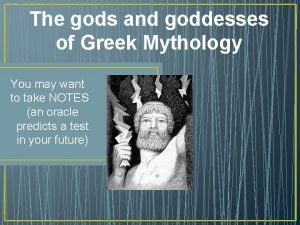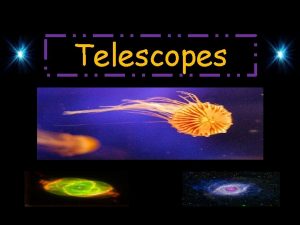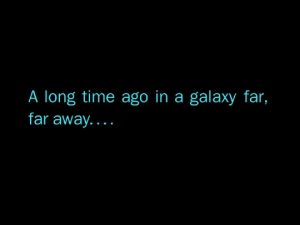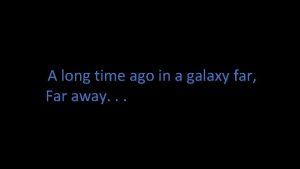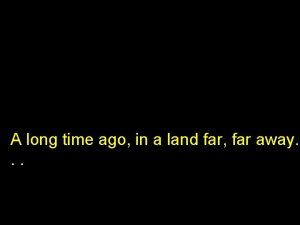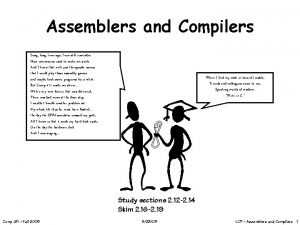A long time ago in a galaxy far






















- Slides: 22

A long time ago in a galaxy far, far away. . . The Sequence of Events that led to the 1963 Publications in Nature of 3 C 273, the first Quasar and the first Extragalactic Jet. Cyril Hazard 1, David Jauncey 2, 3, W. M. Goss 4 and David Herald 5 1: Institute of Astronomy, Cambridge 2: CSIRO Astronomy & Space Science 3: Research School of Astronomy & Astrophysics, ANU 4: National Radio Astronomy Observatory 5: International Occultation Timing Association We would also like to thank Maarten Schmidt for our many valuable discussions

3 C 273 is notable as: • The first Quasar • The first radio Jet • The first inverted spectrum radio source • The first sub-arcsecond radio position • The first sub-arcsecond radio structure • The first radio-optical reference frame tie • The first radio and optical variable extragalactic source • The first black hole

Hubble image of 3 C 273

The discovery of 3 C 273 revolutionised our understanding of the universe. Why is its discovery not widely known or appreciated? The authors (who include one directly involved in the discovery) have reviewed the historical records ….

3 C 273: the cast Maarten Schmidt Cyril Hazard W. Nicholson John Bolton Tom Matthews

the telescopes OVRO Parkes Palomar

1962 and the Three Parkes Occultations • In 1962 Parkes could not track the moon, only the source • May 15 at 410 MHz saw the first ever diffraction fringes • August 5 at 136 and 410 MHz, immersion & emersion • October 26 at 410 and 1420 MHz, immersion only • a big concentration on August and October Between May and August John Bolton “attacked” the Dish, but that’s another story…… it proved unnecessary anyway……

August 5, 1962 occultation 136 MHz Emersion B A Immersion B Moon’s motion Emersion Time 410 MHz A Immersion Dt ~ 30 s ~ 10” A B 3 C 273 is clearly a double source at 410 MHz, aligned so that both components reappear together along P. A. 45 degrees

~10” Therefore separation between A and B has to be ~ 20” ~20” 30 o

On August 20 John Bolton wrote to Maarten Schmidt, and as a “by the way” noted the following coordinates for 3 C 273 (giving no reference as to their origin…) With a postscript…… ……subject to arithmetic errors as yet undetected!

the “Bolton” positions 10” 5” image courtesy Maarten Schmidt

Big question for Maarten Schmidt: ? the “Bolton” positions 10” 5” The “jet” is probably OK, but what about the “star”? image courtesy Maarten Schmidt

Second question is for us: How could John Bolton have gotten this position from Hazard? Could he have miss-read the numbers? Possibly? ? Could he have given the centroid for B? Possibly? ? At 136 MHz component B has effectively disappeared. At 410 MHz the separation was ~20”, so a possible “solution” could be to put B half way between the 410 MHz positions. Could “half-way” just be an interim solution? Possibly? ? Did Hazard mistake the 10” offset? Possibly? ? This is just two weeks after the observations, and was the first time fringes had been analysed. There was insufficient time for Hazard to have communicated with Nicholson.

The Parkes occultation, immersion only, of October 26 1962 TIME Immersion at 410 MHz Immersion at 1420 MHz What is interesting at 1420 MHz is the change in the flux density ratio of the two components with frequency. The spectral index of component B, the more compact, is flat at 0. 0, whereas that of component A is steep at -0. 9. Examination of the August ‘ 62 record shows component A totally dominates at 136 MHz and is ~95% of the total.

For both August and October 1962, Hazard’s 3 C 273 analysis had revealed a “core-jet” structure January 31 st 1963 Hazard wrote to Schmidt with the correct occultation positions for A and B, and suggested a joint publication. This core-jet radio structure now coincided very closely with the optical image. Component B is now clearly the bright STAR!

Component B Component A

Maarten’s 200” spectrum taken December 29 December 1962 image courtesy Maarten Schmidt

He’d been puzzling over it. But on February 6 image courtesy Maarten Schmidt z = 0. 16

It happened on 6 February 1963. In response to Hazard’s letter I decided to have another look at the spectra…. . For reasons that I don’t remember I tried to construct an energy-level diagram. When the energy levels did not come out regularly spaced, I was annoyed…. . To check on the regularity of the observed lines, I decided to compare them with the Balmer lines of hydrogen…. Specifically, I took for each line in 3 C 273 the ratio of its wavelength over the wavelength of the nearest Balmer line. The first ratio was 1. 16, the second was…. . also 1. 16. It suddenly struck me that I might be seeing a redshift. When the third and fourth ratios were also close to 1. 16, it was abundantly clear that I was seeing in 3 C 273 a redshifted Balmer spectrum. Maarten Schmidt, Proc. Amer. Phil. Soc. , 155, 145, 2011

With the discovery of the first quasar our knowledge and understanding of the Universe changed forever.

But that’s another story, too………

 Spiral elliptical and irregular
Spiral elliptical and irregular Once upon a time a long long time ago
Once upon a time a long long time ago Once upon a long time ago
Once upon a long time ago Once upon a time long ago and far away
Once upon a time long ago and far away Once upon a time long ago and far away
Once upon a time long ago and far away Once upon a time there was a poor girl
Once upon a time there was a poor girl Long time ago people
Long time ago people Once there lived a king short story
Once there lived a king short story Long long ago when the gods and goddesses
Long long ago when the gods and goddesses Since long time ago
Since long time ago Long time ago in tagalog
Long time ago in tagalog A long time ago there
A long time ago there A long time ago there
A long time ago there My dear do you know how a long time ago
My dear do you know how a long time ago A long time ago there
A long time ago there Gusty waves figure of speech
Gusty waves figure of speech The paper seeming boy with red eyes means the boy is
The paper seeming boy with red eyes means the boy is In a kingdom far far away
In a kingdom far far away Far far away city
Far far away city Long and short
Long and short Great wall
Great wall Akadians long ago
Akadians long ago Alliteration about the beach
Alliteration about the beach








